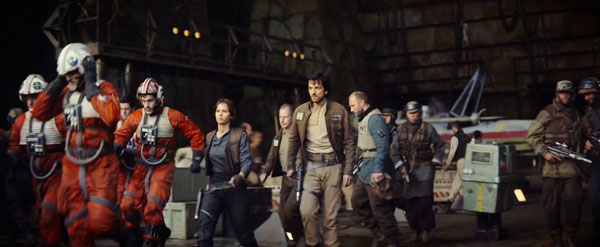In Weary “Rogue One: A Star Wars Story,” Rosencrantz and Guildenstern Take on the Death Star
Written by: Christopher Llewellyn Reed | December 24th, 2016

Rogue One: A Star Wars Story (Gareth Edwards, 2016) 1½ out of 4 stars
Gradually, over the course of the 39 years since the release of the original Star Wars film (now redubbed “Star Wars: Episode IV – A New Hope”), the transmedia universe in which it lives has expanded to include books, video games and television series (animated and otherwise), among other spin-offs. Until now, however, the galaxy of narrative feature films has remained the province of the main through line of the Skywalker family, with three prequels and one sequel (so far), all flowing in one giant narrative arc. With Rogue One: A Star Wars Story, however, the masters of Lucasfilm have broken that tradition, spinning off a side yarn that serves as prequel to that first story. Yes, we had Episodes I-III, but this sets up the immediate given circumstances of the 1977 movie, ending exactly where that other story begins.
Rogue One also introduces an entirely new set of characters who exist solely, it appears, to prepare the way for the champions we already know and love. In other words, this particular movie focuses on supporting players of whose lives we were mostly ignorant until someone, somewhere, decided that their story had to be told. Playwright Tom Stoppard tried this (sort of) with Hamlet, and the resultant existential comedy Rosencrantz and Guldenstern Are Dead shed new light on both the source text and the cavalier way we treat the lives of the insignificant. That was a great experiment. Everyone is a hero in his/her own tale, after all, so why not give us this ancillary adventure, which ideally might broaden our understanding of this great fantasy of our time?
Indeed, why not? Or so I thought before watching it. Ably acted by every single participant – most notably Felicity Jones (The Invisible Woman) and Diego Luna (Blood Father), with especially fine assists from Donnie Yen (Kung Fu Killer), Wen Jiang (Gone with the Bullets), Ben Mendelssohn (Slow West) and Mads Mikkelsen (The Hunt) – Rogue One should be a lot better than it is. But right away it disappoints in a series of poorly-staged action sequences in which Gareth Edwards shows he has learned nothing since the mess of his lumbering Godzilla, cutting his scenes for maximum confusion, mistaking noise for effectiveness. When the film slows down enough for the dialogue to sink in, we realize that the story, such as it is, has been cobbled together from all previous Star Wars films combined, as if a dictum from on high had come down forbidding a fresh perspective. We have an orphaned main character, a witty droid, and a ne’er-do-well cad who may end up doing well if only he could. In spite of itself, it sometimes entertains, but most of the time it begs us to wonder why it had to be made.

The plot revolves around the building of the Death Star, and the Rebel Alliance’s attempts to find the schematics so they can plan its destruction. Our heroine is one Jyn Erso (Jones), daughter of Galen Erso (Mikkelsen), the engineer impressed into serving the Empire and designing the mega-weapon. We learn that he has created a weak spot that, if hit by a missile, will cause a chain-reaction explosion that will … well, we’ve seen that movie. And so the film becomes a race to find the hidden plans before the Empire can discover the Achilles heel in their new pride and joy. How do you think it ends?
To be fair, the filmmakers seem as aware of the inherent problem in the design of the movie as they are of that of the Death Star: how to make a story with a known conclusion still exciting? And there are occasional surprises – most of them depressing and gruesome – in store for those who choose to see the film (and two unwelcome surprise CG characters – one late actor resurrected and one older actor made young again – that put the uncanny in valley, and then some). But what is gained by the experience? Is it worth the 133 minutes of our time? More importantly, if the deities of the Lucasverse continue with these supporting stories, will it dim the luster of the remaining two episodes? More is usually not more, and though I enjoyed last year’s The Force Awakens (which came with its own problems with originality), I wasn’t exactly clamoring to know everyone’s backstory. With an upcoming roster of anthology films, however, it seems like we soon will. There goes the galaxy …

